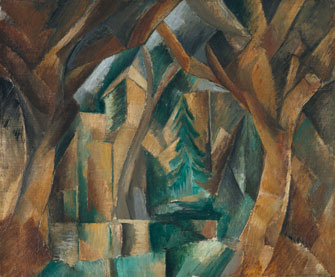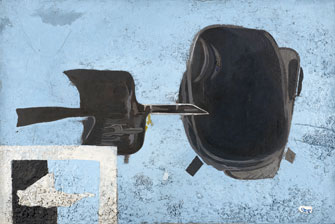Beyond Cubism:
The Whole Picture

“Le Parc de Carrières-Saint-Denis” (1909-10). © Museo Thyssen-Bornemisza © Adagp, Paris 2013
“Georges Braque,” one of Paris’s blockbuster autumn art exhibitions, opening today at the Grand Palais, walks us through nearly the whole career of the artist (1882-1963) known primarily for the invention of Cubism with his friend and colleague Picasso, offering a rare opportunity to see the development of his work over the years – it’s been 40 years since the last retrospective – and filling us in on what the artist was up to before and after the Cubist period.
The exhibition starts with Braque’s Fauvist period (in fact, he had previously dabbled in Impressionism, but none of those works are on show here). Following in the footsteps of one of his heroes, Cézanne, Braque, who was attracted by the “physicality” of Fauvism, went to the French fishing village of L’Estaque and turned out one pretty, colorful scene after another. A number of these works are included in the exhibition, and while they are lovely, they look like copycats, with a softer palette, of the work of his Fauvist forerunners.
Braque soon left Fauvism behind, however, and started fragmenting images à la Cézanne and toning down his palette to muted greens and ochers, in a style some now refer to as Cézannian Cubism. These are accomplished works that often border on abstraction. One of the more abstract of them, “Arbres à l’Estaque” (1908), effectively pulls the viewer into a maelstrom of trees.
In Montmartre and the French town of Céret, this style evolved into what is called Analytic Cubism as Picasso and Braque experimented, theorized and challenged each other. Color pretty much went out the window, sacrificed to form and scorned as too sensual and emotional, an approach that was the direct opposite of that taken by the Impressionists and Fauvists. The image was increasingly fractured, and the palette was limited to tone-on-tone brown, green, gray and beige. This was cerebral art, so far from nature that it was in danger of falling into ascetic hermetism, as the art historian Dominique Dupuis Labbé points out. The exhibition does an excellent job of illustrating the loss of color and the explosion of reality into facets in the successive periods of the artist’s work.
Cubism moved back a bit toward the real world in its “Synthetic” phase as Braque began to paste pieces of wood-grained wallpaper on his paintings and Picasso started to use collage techniques. Stenciled letters and numbers also began to appear in their works.
World War I brought an end to the evolution of Cubism and the collaboration of the two artists. Picasso moved on to other things, while Braque went to war and was severely injured. When he returned to painting afterward, he restored color to his canvases and continued to paint in a softer Cubist vein, sometimes with distinct echoes of Matisse.
During the rest of his career there were few exciting developments – aside from a postwar detour into neoclassicism with the “Canéphores” (1922), massive Picassan female

“À Tire d’Aile” (1956-61), one of Braque’s later works. © Centre Pompidou, MNAM-CCI, Dist. RmnGrand Palais/Adam Rzepka © Adagp, Paris 2013
figures – until a few years before his death, when he began to paint large abstracted birds and rather beautiful small horizontal landscapes, simplified to the maximum and painted in striking colors, works that influenced French painter Nicolas de Staël (1914-55), a great admirer of Braque.
An anecdote: the term “Cubism” grew out of a comment made by Matisse about “little cubes” in Braque’s paintings when he saw the landmark 1908 exhibition of the artist’s works organized by poet Guillaume Apollinaire at the Galerie Kahnweiler in Paris.
While it is fascinating to see the development of Cubism through Braque’s work, the exhibition makes it clear why the artist’s non-Cubist work is less valued. It lacks the dynamism of that exciting early period of discovery and experimentation, and often seems more like a reworking of past ideas and the styles of other artists, notably Matisse in some of the interior scenes.
Galeries Nationales du Grand Palais: 3, avenue du Général Eisenhower, 75008 Paris. Métro: Champs-Elysées Clemenceau. Tel.: 01 44 13 17 17. Open Wednesday-Saturday, 10am-10pm; Sunday-Monday, 10am-8pm. Closed Tuesday and December 25. Admission: €12. Through January 6, 2014. www.grandpalais.fr
Click here to read all of this week’s new articles on the Paris Update home page.
Reader reaction: Click here to respond to this article (your response may be published on this page and is subject to editing).
Please support Paris Update by ordering books from Paris Update’s Amazon store at no extra cost. Click on your preferred Amazon location: U.K., France, U.S.
More reviews of Paris art shows.
© 2013 Paris Update
Favorite